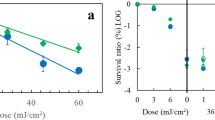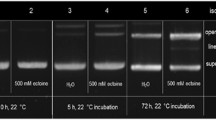Abstract
Using cells that overproduce DNA photolyase, we found that UV irradiation (3 J/m2) efficiently inactivates accumulation of methylthiogalactoside (TMG) when RexAB proteins of phage lambda are present. The effect requires both formation of photolyase-dimer-DNA (PDD) complexes and expression of the RexAB proteins. It is reversed completely by a flash of visible light if given immediately after UV and becomes irreversible after post-UV incubation for about 15 min. Inactivation is significant after only 5 min of post-UV incubation, is accompanied by a loss of previously accumulated TMG, and does not require de novo protein synthesis. Passive transport of O-nitrophenylgalactoside by inactivated cells is typical of energy-depleted membranes. We suggest that PDD complexes mimic a developmental intermediate of phage superinfection and stimulate formation of the RexB membrane channel recently proposed by others to explain classical “exclusion”. This suggestion is supported by additional data showing an inactivation of colony-forming ability by exclusion stimulation and an inability of PDD complexes to inactivate accumulation of TMG if RexB is present in larger relative amounts than RexA (a detail characteristic of exclusion stimulated by phage superinfection).
Similar content being viewed by others
References
Barth KA, Powell D, Trupin M, Mosig G (1988) Regulation of two nested proteins from gene 49 (recombination endonuclease VII) and of a λ,-rexA-like protein of bacteriophage T4. Genetics 120:329–343
Benzer S (1955) Fine structure of a genetic region in bacteriophage. Proc Natl Acad Sci USA 41:344–354
Drlica K (1987) The nucleoid. In: Neidhardt FC, Ingraham JL, Low KB, Magasanik B, Schaechter M, Umbarger HE (eds) Escherichia coli and Salmonella typhimurium. Amer Soc Microbiol, Washington DC, pp 91–103
Husain I, Sancar GB, Holbrock SR, Sancar A (1987) Mechanism of damage recognition by Escherichia coli DNA photolyase. J Biol Chem 262:13188–13197
Kaback HR (1986) Active transport in Escherichia coli. In: Andreoli TE, Hoffman JF, Fanestil DD, Schultz SG (eds) Physiology of Membrane Disoders. Plenum Press, New York, pp 387–407
Kennedy EP (1970) The lactose permease system of Escherichia coli. In: Beckwith JR, Zipser D (eds) The Lactose Operon. Cold Spring Harbor Laboratory, New York, pp 49–92
Koch AL (1964) The role of permease in transport. Biochim Biophys Acta 79:177–200
Landsmann J, Kroger M, Hobom G (1982) The rex region of bacteriophage lambda: two genes under three-way control. Gene 20:11–24
Li BH, Kwasniewski M, Bockrath R (1991) Inactivation of lacZ gene expression by UV light and bound DNA photolyase implies formation of extended complexes in the genomes of specific Escherichia coli strains. Mol Gen Genet 228:249–257
Li BH, Kwasniewski M, Kirchner J, Bockrath R (1992) RexAB proteins of bacteriophage λ enhance the effect of photolyasedimer complexes on lacZ gene expression in Escherichia coli. Mol Gen Genet 231:480–484
Matz K, Schmandt M, Gussin GN (1982) The rex gene of bacteriophage λ is really two genes. Genetics 102:319–327
Mosig G (1987) The essential role of recombination in phage T4 growth. Annu Rev Genet 21:347–371
Parma D, Snyder M, Sobolevski W, Nawroz M, Brody E, Gold L (1992) The Rex system of bacteriophage λ: tolerance and altruistic cell death. Genes Devel 6:497–510
Sancar GB, Smith FW, Sancar A (1985) Bindig of Escherichia coli DNA photolyase to UV-irradiated DNA. Biochemistry 24:1849–1855
Schoulaker-Scharz R, Devel-Gorodetsky L, Engelberg-Kulka H (1991) An additional function for bacteriophage λ, rex: the rexB product prevents degradation of the O protein. Proc Natl Acad Sci USA 88:496–500
Singer BS, Shinedling ST, Gold L (1983) The rII genes: a history and a prospectus. In: Mathews CK, Kutter EM, Mosig G, Berget PB (eds) Bacteriophage T4. Amer Soc Microbiol, Washington DC, pp 327–333
Snyder L, McWilliams K (1989) The rex genes of bacteriophage lambda can inhibit cell function without phage superinfection. Gene 81:17–24
Toothman P, Herskowitz I (1980) Rex-dependent exclusion of lambdoid phages. III. Physiology of the abortive infection. Virology 102:161–171
Yamamoto K (1992) Dissection of functional domains in Escherichia coli DNA photolyase by linker-insertion mutagenesis. Mutat Res 232:1–6
Yamamoto K, Satake M, Shinagawa H (1984) A multicopy phr-plasmid increases the ultraviolet resistance of a recA strain of Escherichia coli. Mutat Res 131:11–18
Author information
Authors and Affiliations
Additional information
Communicated by R. Devoret
Rights and permissions
About this article
Cite this article
Li, BH., Bockrath, R. Photolyase-dimer-DNA complexes and exclusion stimulation in Escherichia coli: Depolarization of the plasma membrane. Molec. Gen. Genet. 240, 450–454 (1993). https://doi.org/10.1007/BF00280400
Received:
Accepted:
Issue Date:
DOI: https://doi.org/10.1007/BF00280400




